Curry Leaves make a wonderful plant for your aromatic herb recipes. The Curry Leaf tree is an attractive, upright, evergreen tree native to India and Sri Lanka. It belongs to the family member Rutaceae.
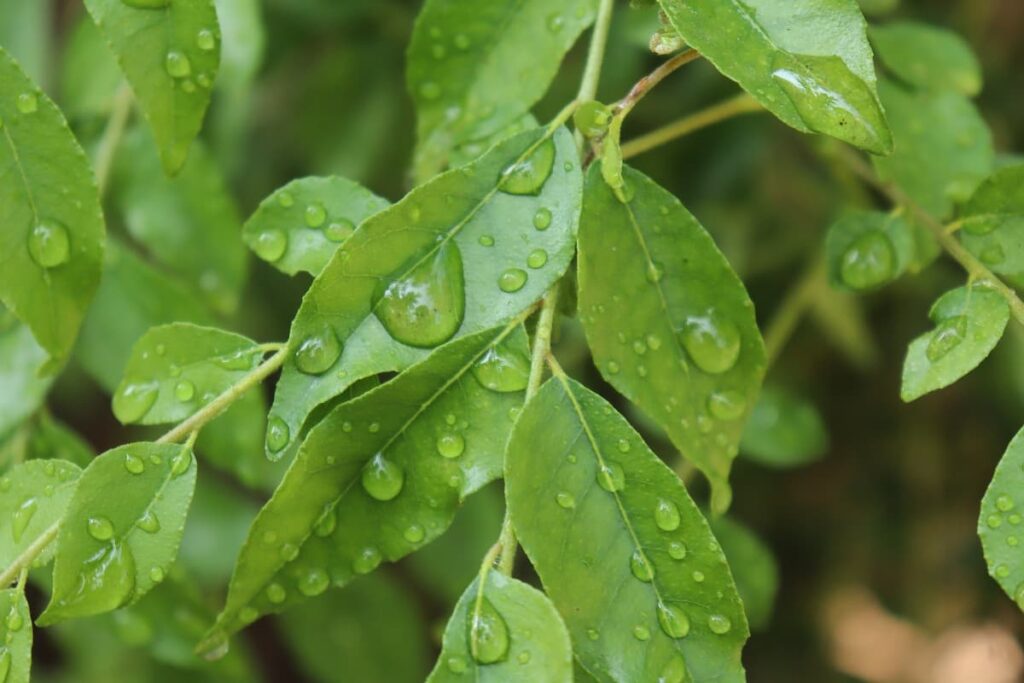
How to make Curry Leaf plant bushy
The best soil for growing Curry Leaf plants
- Curry Leaf plants require well-drained soil to grow. Lack of proper drainage causes root rot, eventually leading to the plant’s death.
- You can mix 50% regular garden soil with 25% perlite and 25% compost for the best potting soil. You can also buy soil mix on online shopping websites.
- Plants need loose, rich, well-drained soil. In addition, the soil must be slightly acidic, with a pH of 5.6-6.0.
- Curry Leaf dislikes wet feet. Therefore, Curry Leaf plants require well-drained soil with cow dung or organic manure and river sand.
Homemade and natural fertilizer for Curry Leaf plant
- Curry Leaf plant responds positively to homemade fertilizers like buttermilk, rice water, asafoetida, wood ash, banana peel, and eggshells, which can be applied weekly. And they can also work great as a fertilizer for your Curry Leaf plant.
- Curry Leaf plants benefit significantly from regular feeding of fertilizers high in nitrogen (N) value. Apply an application of blood meal in the spring, followed by a monthly application of seaweed or fish fertilizer.
- Regarding Curry Leaves, the best natural fertilizer you can use is compost. Like any other plant, adding compost to the soil will help provide nutrients and improve drainage. If you cannot make your compost, you can buy it from a garden store.
- In addition to using fertilizer, there are other things you can do to keep your Curry Leaf plant healthy. Ensure you water it regularly and cut it back if it gets too big. Also, please protect it from frost in winter by covering it with a cloth or moving it indoors.
Banana peel compost for Curry Leaf plant
The peel is also rich in copper and zinc. The best time to use this fertilizer is during the rainy season when you can add it directly to your Curry Leaf plant’s soil or potting mix for better absorption by the roots. Banana peel compost is also good for Curry Leaf plants. This fertilizer is nitrogen-rich. This fertilizer can be applied to many plants and the garden.
Tips for using banana peel as fertilizer for Curry Leaf plants
- Step 1: Cut the banana skin into small pieces.
- Step 2: Place it under the sun and let it darken.
- Step 3: Apply directly to the soil or grind it into a powder and then apply it to the soil.
The best compost for growing Curry Leaf plant
The best compost is a mixture of one part peat moss to one part perlite. This mixture will give your plant the necessary drainage while retaining moisture. You can add a little sand to this mixture if you want. Compost improves soil structure, loosens the soil, and facilitates root penetration. Additionally, it helps retain water in the potting soil. Before using compost for your Curry Leaf plant, bake or dehydrate it properly. Otherwise, it can burn your plant or acidify the soil.
Tips for using compost for Curry Leaf plants
- Add a trowel full of compost to a 14-diameter clay pot, and add more for a larger pot.
- Gently mix the top layer of soil, avoiding damaging the roots.
- Water well.
- Fertilize every 3-6 months as needed.
In case you missed it: How to Grow Curry Leaves in the USA: From Seeds in Containers at Home, A Step-By-Step Guide for Beginners
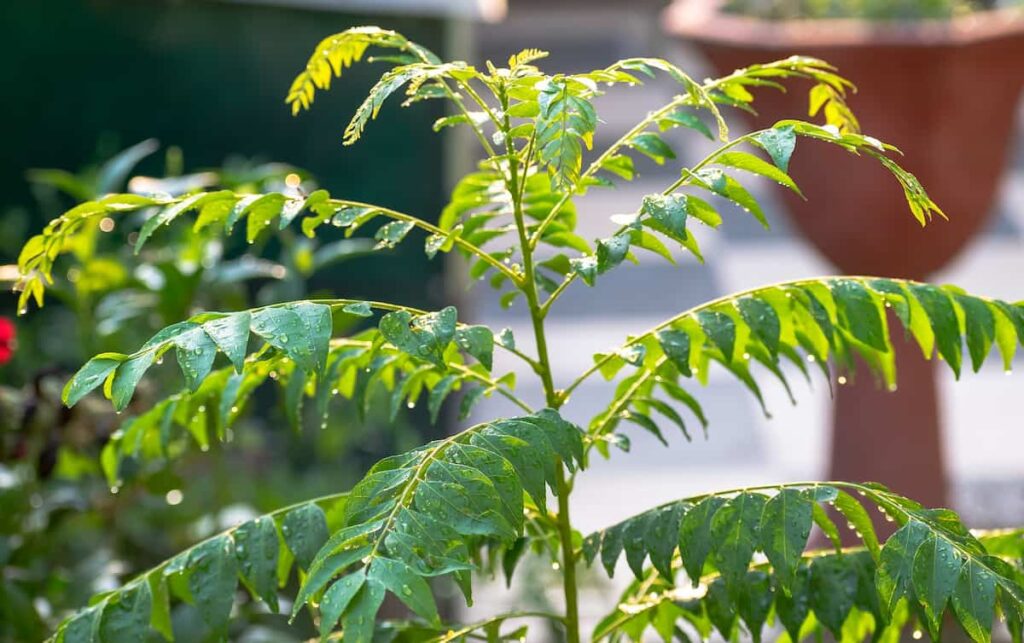
Asafoetida (AKA ‘Hing’) for Curry Leaf plants
Asafoetida promotes new top shoots and baby leaves on Curry Leaf plants. Although no scientific research supports this belief, many gardeners use Asafoetida as a growth stimulant for Curry Leaf plants and are happy with the results. For better results, apply asafoetida mixed with a buttermilk mixture.
Tips to apply Asafoetida to the Curry Leaf plants;
- Prepare the buttermilk mixture.
- Add ¼ teaspoon of powdered Asafoetida to the mixture.
- Mix well and pour the mixture over the base of the Curry Leaf plant.
Use of Buttermilk for Curry Leaf plant
Buttermilk is high in nitrogen and phosphorus, which provide essential nutrients for growth. Moreover, buttermilk makes the soil slightly acidic, which benefits Curry plants. It is also high in probiotic bacteria that enhance the Curry plant’s ability to fight fungi, such as blind spots and powdery mildew. There are several reasons why buttermilk is an excellent home fertilizer for Curry Leaves.
It is high in nitrogen which Curry Leaf plants require. In addition, buttermilk makes the soil acidic, which the Curry Leaf plant likes. Finally, buttermilk contains probiotic bacteria, which not only increase the level of soil bacteria but also help the Curry plant fight fungal infections like black spots and powdery mildew.
Tips to apply buttermilk;
- Let the potting soil dry a little before applying buttermilk.
- Mix 2 tablespoons of sour curd or curd in 1 gallon of water.
- Pour the mixture over the base of the Curry Leaf plant.
- Apply weekly.
How does Curry Leaves grow faster?
For Curry Leaves to grow faster, pruning is essential, encouraging multiple branches and more Leaves for harvesting. In addition, fertilizing (liquid fertilizer) is necessary every third to the fourth week so that the Curry Leaf plant gets enough nutrients. Plant in the ground instead of in a pot for faster plant growth. Pinch the tips of the branches when they are young and multi-branched; this will encourage the Curry Leaves to keep the Curry Leaf plant busy and growing fast.
The growth rate of potted plants is less than that planted on the ground. The bigger the plant, the more branches, and leaves we get. Still needs pruning and fertilizing whether planted in a pot or the ground. Dissolve about 1oneteaspoon of Epsom salt (magnesium sulfate) in 1 liter of water and feed the Curry Leaf plant when dry. Give Epsom salt every 3 months. Then, your Curry Leaf plant will grow quickly and very well. It will grow green leaves throughout the spring, summer, and fall.
Coffee grounds for Curry Leaf plants
Coffee grounds are the most important nutrients your Curry Leaf plants need. Coffee grounds also contain potassium, phosphorus, calcium, magnesium, and sulfur.
In case you missed it: Growing Curry Leaf Plant from Cuttings, Seed (Kadi Patta)
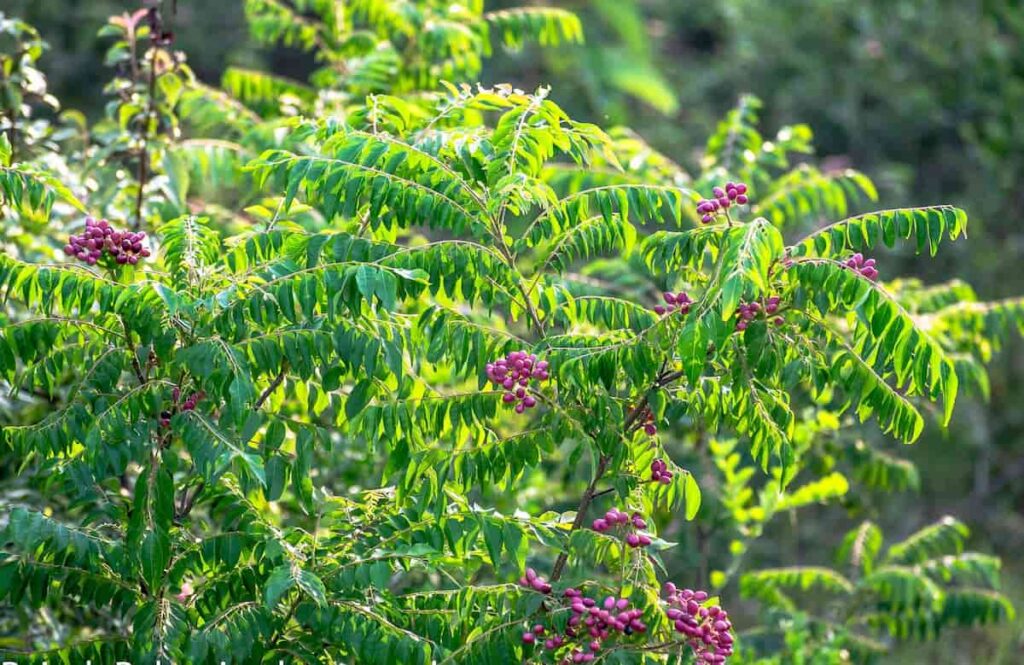
Because coffee grounds contain micronutrients such as copper and zinc (needed for root growth), it is an excellent fertilizer for Curry Leaf plants recently grown in containers or raised beds. Later they are transplanted into the soil. In addition, adding coffee grounds to the soil increases acidity, which benefits the gourd plant.
Reasons why your Curry Leaf plant is not growing
The main reasons a Curry plant won’t grow leaves are lack of sunlight, cold temperatures, or a nutrient problem. It’s frustrating when you put all your effort into growing a Curry Leaf plant only to find that it won’t grow. There are some possible reasons for this. Firstly, make sure you are giving the plant enough water. Curry Leaf plants need to be kept moist but not wet. Second, check the temperature of the room where the plant is located.
Curry Leaf plants prefer warm temperatures and will not do well in cool or cool rooms. Third, make sure the plant gets enough light. Curry Leaf plants need at least six hours of direct sunlight daily to thrive. If your plant is still not growing after taking these steps, there may be something wrong with the plant’s roots or stem. If this is the case, starting over with a new plant is best.
If the Curry plant is dying, it has hydration issues, insect infestation, soil issues, or not getting enough sunlight. Curry Leaf plants are very easy to care for, but a dying plant should be taken care of as soon as possible if you want to revive it. Things like dry soil, minimal light, fungal problems, or neglect will cause it to lose its vigor and wilt.
Tips to revive a dying Curry Leaf plant
Before you hit the road to revive your dying Curry plant, you’ll need to find out why it died. Troubleshooting the problem and looking at its foliage can help you determine what’s going on. For example, if the leaves are yellow, brown, or wilted, this may indicate a fungal problem or a water problem. It can also indicate nutritional problems that need to be addressed. Start by doing a pH test and checking the soil’s hydration level. You can buy a pH testing kit online. You can stick your index finger about 2 inches into the soil for a hydration test.
The soil should be loose, moist, and well-drained. If not, water the plant well and monitor it for a few days. If the soil is too moist, ensure the plant gets plenty of sunlight daily. Also, check the ambient temperature to ensure the plant is not too cold. The fastest way to revive the plant is to repot the plant with healthy soil. You may also want to limit watering until the plants have established roots. Finally, ensure the plant gets full sunlight daily and is in a warm environment.
Using tea bags/leaves for Curry Leaf plant
Fresh or used tea leaves have tannic acid (tannin), which, when added to the soil, increases nitrogen levels in the soil and creates a fertile environment for plants. Nitrogen is a very important component for plant growth and development. Although nitrogen is one of the most abundant commodities in the world, the possibility of nitrogen deficiency is a common problem affecting plants worldwide.
Nitrogen is not directly available to plants from the atmosphere and the earth’s crust. Most importantly, plant nitrogen deficiency disrupts chlorophyll production and inhibits plant food production. The presence of natural organic matter in tea leaves increases the level of nutrients required by the plants and improves soil quality. In addition, it attracts earthworms and other beneficial microorganisms and increases their activity.
Please make sure the leaves are dry before using them as fertilizer. You can use green or black tea leaves, but you will get better results with green tea. When preparing a pot for planting Curry Leaves, crush the leaves into small pieces and mix them with your soil or compost. Using this method, you won’t have to worry about storing the tea leaves in an airtight container because they will have already broken down by the time you’re ready to use them.
In case you missed it: Growing Curry Leaf Plants in Pots / Containers
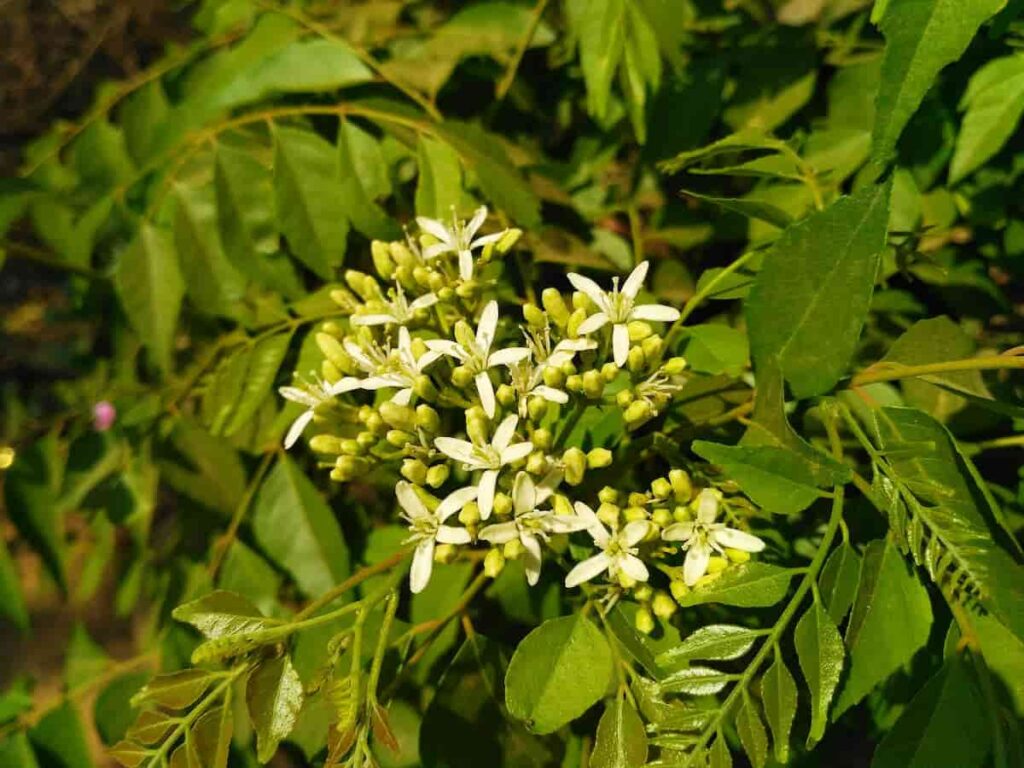
Best organic fertilizer for Curry Leaf plant
Organic fertilizer is fertilizer made from plants, animal waste, and carcasses. It is produced by decomposing or processing naturally derived products to feed plants, increase soil fertility, and improve the quality of soil binding. Organic fertilizer ingredients are usually obtained from vegetable and animal by-products.
Farmyard manure (FYM)
Farmyard manure refers to a melted mixture of dung, farm animal waste, and excess bran or animal feed materials. Well-digested fertilizers contain an average of 0.5% nitrogen, 0.2% phosphate and 0.5% potash.
Earthworm manure
Fertilizer made with the help of earthworms is called slime cast or vermicompost. Eisenia foetida, Eudrilus eugeniae, and Perionyx excavatus are the main slime species used to make slime compost or vermicompost.
Poultry manure
Poultry droppings can be turned into powerful organic fertilizers for Curry Leaf plants through the deep litter. If necessary, the birds are allowed to grow on grass clippings, leaves, or fine wood dust, and the litter is changed once a week.
Liquid fertilizers
Liquid fertilizers are formulated for direct application to plants. They require less amount of solid fertilizer. The efficiency of these liquid fertilizers is high because plants can absorb them directly through the leaves. Various experiments have shown that the Curry plant leaves absorb nutrients 20 times faster than the roots.
Is eggshell good for Curry Leaf plants?
Eggshells contain more than 95% of minerals. Eggshells contain mainly calcium carbonate (37%), which is essential for plant growth. In the absence of calcium, young tips develop poorly, and their number decreases over time. In addition, without calcium, Curry Leaf margins become dead and scorched, roots become weak, and plants fall. Thus, eggshells help increase calcium in Curry plants. Eggshells are also high in phosphorus. Phosphorus greatly affects the fruits and flowers of the Curry Leaf plant.
Phosphorus is essential for the root and stem growth of Curry Leaves. It is essential for pollination and seed germination. Phosphorus helps plants produce lots of flowers and fruits. Eggshells also contain magnesium, potassium, and iron. In addition, crushed eggshells provide calcium, one of the most important nutrients for plant health. Calcium promotes vigorous growth as well as strong root systems and green plants.
How long does it take a Curry Leaf plant to grow?
- Harvesting Curry Leaves is easy and improves the future growth of the plant. Once it grows, you can break off the leaves.
- This plant grows continuously for 1-2 years with healthy and fragrant Leaves. It takes about 1 year for a Curry Leaf plant to grow 6 inches.
Is it good or bad to use rice water for Curry Leaves plants?
- Watering plants with fermented rice water is the best remedy.
- Mix fermented rice water with double the amount of normal water and spray on the leaves to kill the insects.
- Rice water helps in the development of tender leaves. Therefore, do not allow water to collect under the Curry Leaves.
How often should we water a Curry Leaf plant to make it bushy?
- A Curry Leaf plant requires moderate watering to maintain. Do not keep the soil too wet. Water the Curry Leaf plant only when you see the top 1 to 2 inches of soil completely dry. It likes dry spells between 2 consecutive waterings.
- Care must be taken with watering routines, especially in the winter, as overwatering during the winter months kills the plant.
How do I make my Curry plant bushy?
Pruning Curry Leaf plants can be done during the growing season to keep the tree bushy and to provide a large crop of leaves for freezing. By cutting off the top of the branch (removing this dominant tip), the plant will begin to produce side shoots to fill the gap left behind by the main stem. Those side shoots will grow into new branches, filling the plant’s shape and making it bushier.
Step-by-step instructions on how to prune a Curry Leaf plant;
- Start by removing the old yellow leaves.
- Remove stems that have lost leaves.
- Make a clean cut with a sharp cut at least 1/3 from the top of the plant. It may seem harsh, but it is necessary to include the plant’s size and make it bushier.
- If the mature plant has developed thick branches.
- Within 2 to 3 weeks, it will shoot out multiple branches below the cut. More plant branches mean more leaves later in the season.
Pruning will help prevent the Curry Leaf plant from branching out and becoming bushy and leggy. It is best to cut off branches with flowers on mature plants as they will rob the plant of energy by growing more leaves. Avoid pruning the plant in winter, as it can damage the plant. Finally, wait at least 2-3 weeks before harvesting a recently transplanted Curry Leaf plant.
In case you missed it: Curry Leaves Farming a Profitable Business (Kadi Patta)
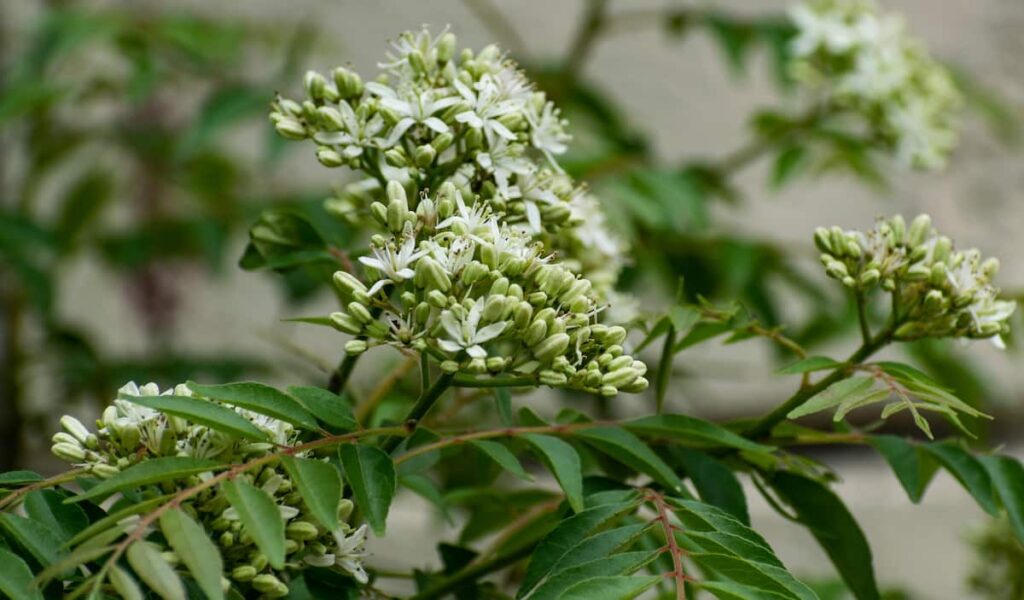
Pruning is essential to produce more leaves and keep your Curry Leaf plant healthy and looking its best. However, one of the most common problems people face when harvesting a Curry Leaf plant is not knowing when to do it. Another problem is not knowing how to properly prune a Curry Leaf plant, which can lead to over- or under-pruning and negatively affect the plant’s health. A Curry Leaf plant cannot survive below-freezing temperatures.
Therefore, potted Curry Leaf plants must be moved to a temperature-controlled indoor environment during the colder months. Harvesting the plant in early fall can move in and out more quickly as temperatures change and require less space indoors. During pruning, dead stems and leaves are removed to improve air circulation in the plant. In addition, it can help reduce the chances of disease and insect infestation on plants.
Crossed branches are also removed when pruning a Curry Leaf plant, so they don’t rub against each other and scar the outer layer, which allows insect and bacterial spores to enter the plant tissue. The best time to prune a plant is when it is actively growing, i.e., in spring, summer, and early fall. However, you should avoid pruning a Curry Leaf plant when preparing for colder weather in the late fall and winter months. During these times, pruning a plant shocks the plant and can damage new growth.
How can I increase the growth of the Curry Leaf plant?
If you want to boost the growth of your Curry plant, you can do a few things. Firstly, make sure it is getting enough sunlight. It should be in an area with at least six hours of sunlight. Second, water it regularly and deeply. Third, use a balanced fertilizer to fertilize your Curry plant every two to four weeks. Fourth, if it gets too leggy or rough, cut it back.
Tips for making Curry Leaves grow more branches
If you want to improve the branches of your Curry Leaf plant, you can do a few things. Firstly, reduce the amount of water you give it. Too much water can lead to fewer branches. Fertilize regularly with a balanced fertilizer. Third, periodically prune the main stem and dead or dying leaves to encourage new growth. Finally, ensure it gets enough sunlight – at least six hours per day is ideal.
Reasons why your Curry Leaf plant turns yellow
- Curry Leaf plant turns yellow mainly due to the chlorosis plant’s lack of iron, manganese, zinc, or nitrogen. Therefore, it is common for Curry Leaves to turn yellow in early winter and fall. Hence, it is called winter dormancy.
- If your Curry Leaf plant is turning yellow, it could be due to several reasons. It could be a lack of nutrients, too much water, or too much sun.
- Curry Leaves may experience moderate yellowing (chlorosis) on their leaves during winter. Cold temperatures seem to be a major factor in this Leaf problem. It often indicates that the plant is getting ready to go into dormancy.
Using neem oil for Curry Leaf plant
- Start spraying with neem oil every two weeks. Neem oil helps control harmful insects and protects plants from fungal and bacterial infections.
- Use ready-to-use neem oil, mix 2 to 4 tablespoons of concentrate in 1 gallon of water and spray Curry plants with it. Before applying neem oil, water the Curry Leaves inside and outside to cover their leaves and stems.
Can you grow Curry Leaves from cuttings?
Curry Leaf plants can be grown well from cuttings or seeds.
Propagation by stem cuttings
Choose a semi-hardy and semi-green branch with 2-3 leaves attached. Make a clean cut under the branch. Remove the plant leaves at the bottom of the branch that will go into the soil. Use rooting hormone if you have it, or dip the bottom of the branch in cinnamon powder/turmeric powder to encourage root growth. Dig up about 2-3 inches of topsoil. Place the cutting in the hole. Cover the hole with soil to keep the branch strong. Water the soil and then place the container in a shady spot. You can cover the top with plastic to retain heat and moisture. It will develop roots in 3-6 weeks.
Harvesting tips for Curry Leaves
Many people harvest the leaves and leave the Leaflet branch attached to the plant. It is an incorrect method of harvesting because the plant will continue to divert energy to the Leaflet branch without producing leaves. When harvesting, cut off the entire Leaf and the branch for use. Pruning properly promotes more plant growth.
Harvesting the Curry Leaf plant for cooking is very easy. All you have to do is pluck a few leaves from the plant. The leaves are flavorful when picked fresh, so you don’t want to let them dry out. Also, the more leaves you pluck from the plant, the more the plant will grow.
In case you missed it: Curry Leaf Farming Project Report, Cost, Profits Guide
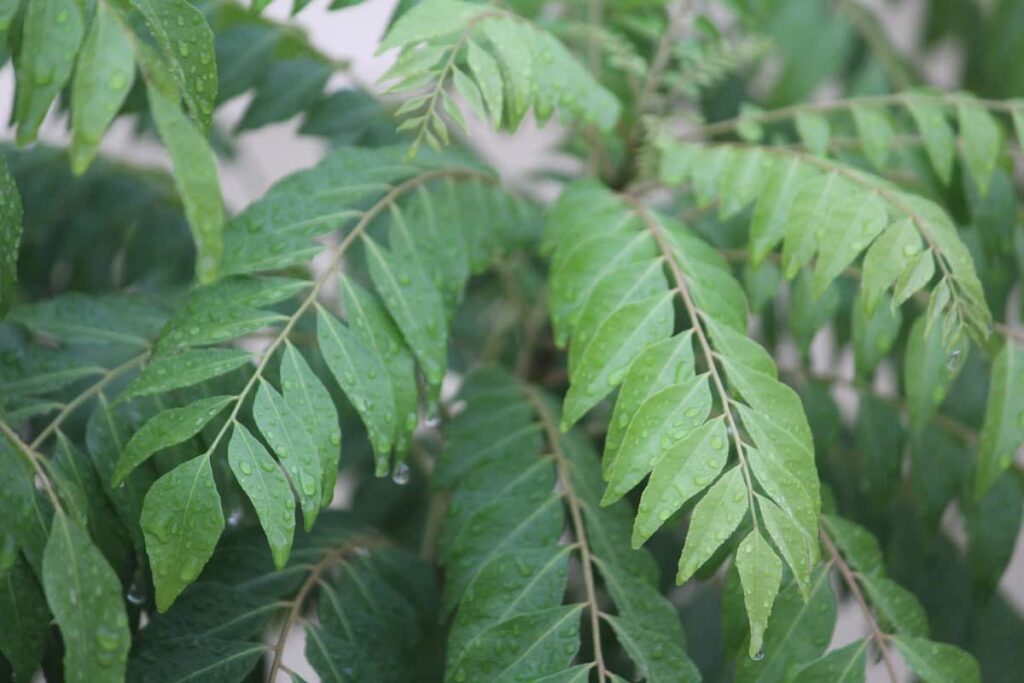
Is Epsom salt good for Curry Leaf plants?
If your Curry Leaf plant lacks a lush green color or looks yellow all over, it may be deficient in magnesium. Epsom salt contains magnesium and sulfur. Although Epsom salt is not a fertilizer, it provides essential nutrients to enhance the effectiveness of the fertilizer. For example, it helps plants increase chlorophyll production and helps restore the green color of leaves. In addition, Epsom salt contains magnesium and sulfur, which is great for Curry plant growth.
How to apply Epsom salt to curry leaf plants?
- Dissolve about two tablespoons of Epsom salt per 1 gallon of water.
- Gently pour the mixture over the base of the Curry Leaf plant.
- It can also be applied as a foliar spray – spray the solution directly on the Leaves and soak them.
- Apply monthly through early fall.
Conclusion
Curry Leaves are excellent nutrient sources and can be used for several health benefits. Pruning the branches of Curry Leaf plants is an important task to make Curry Leaf plants bushy. If you prune the Curry Leaf plant, you will get more branches; more branches will result in more Leaves.
- Economical Aquaculture: A Guide to Low-Budget Fish Farming
- 15 Common Planting Errors That Can Doom Your Fruit Trees
- How to Make Houseplants Bushy: Effective Tips and Ideas
- Innovative Strategies for Boosting Coconut Pollination and Yield
- Pollination Strategies for Maximum Pumpkin Yield
- The Complete Guide to Chicken Fattening: Strategies for Maximum Growth
- Natural Solutions for Tulip Problems: 100% Effective Remedies for Leaf and Bulb-Related Issues
- Revolutionizing Citrus Preservation: Towards a Healthier, Greener Future
- Natural Solutions for Peony Leaf and Flower Problems: 100% Effective Remedies
- Maximizing Profits with Avocado Contract Farming in India: A Comprehensive Guide
- Natural Solutions for Hydrangea Problems: 100% Effective Remedies for Leaf and Flowers
- The Ultimate Guide to Choosing the Perfect Foliage Friend: Bringing Life Indoors
- From Sunlight to Sustainability: 15 Ways to Use Solar Technology in Agriculture
- The Ultimate Guide to Dong Tao Chicken: Exploring from History to Raising
- The Eco-Friendly Makeover: How to Convert Your Unused Swimming Pool into a Fish Pond
- Mastering the Art of Delaware Chicken Farming: Essentials for Healthy Backyard Flocks
- 20 Best Homemade Fertilizers for Money Plant: DIY Recipes and Application Methods
- How to Craft a Comprehensive Free-Range Chicken Farming Business Plan
- Brighten Your Flock: Raising Easter Egger Chickens for Beauty and Bounty
- How to Optimize Your Poultry Egg Farm Business Plan with These Strategies
- Subsidy for Spirulina Cultivation: How Indian Government Schemes Encouraging Spirulina Farmers
- Ultimate Guide to Raising Dominique Chickens: Breeding, Feeding, Egg-Production, and Care
- Mastering the Art of Raising Jersey Giant Chickens: Care, Feeding, and More
- Ultimate Guide to Raising Legbar Chickens: Breeding, Farming Practices, Diet, Egg-Production
- How to Raise Welsummer Chickens: A Comprehensive Guide for Beginners
- How to Protect Indoor Plants in Winter: A Comprehensive Guide
- Ultimate Guide to Grow Bag Gardening: Tips, Tricks, and Planting Ideas for Urban Gardeners
- Guide to Lotus Cultivation: How to Propagate, Plant, Grow, Care, Cost, and Profit
- Agriculture Drone Subsidy Scheme: Government Kisan Subsidy, License, and How to Apply Online
- Ultimate Guide to Raising Araucana Chickens: Breed Profile, Farming Economics, Diet, and Care
- Bringing Hydroponics to Classroom: Importance, Benefits of Learning for School Students
- Ultimate Guide to Raising Polish Chickens: Breed Profile, Farming Economics, Diet, and Care
- Ultimate Guide to Raising Australorp Chickens: Profile, Farming Economics, Egg Production, Diet, and Care
- Silkie Chicken Farming: Raising Practices, Varieties, Egg Production, Diet, and Care
- Sussex Chicken Farming: Raising Practices, Varieties, Egg Production, Diet and Care
- Homemade Feed Formulations for Livestock: Discover Cost-effective Starter to Finisher Feed Recipes